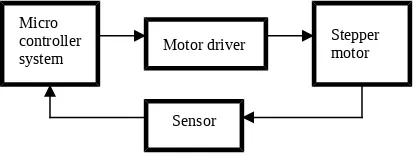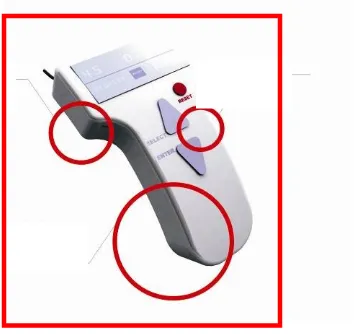Design and Realization of Microcontroller-Based Continuous Passive Motion
Device to Prevent Shoulder Joint Stiffness
Hermawan N.R., Tati R.M., Soegijardjo S., Mutia R., Detriana M and Dody Aprianto
Biomedical Engineering Program, School of Electrical Engineering and Informatics
Institut Teknologi Bandung (ITB), Indonesia
ABSTRACT
The design and realization of a microcontroller-based Continuous Passive Motion device (CPM) for shoulder joint recovery was done. This machine can be used after performing an operation, or for patients suffering from joint motion limitation due to early stage of frozen shoulder. The system consists of a MCS-51, a motor driver and stepper motor, a mechanical module and a forearm orthotic. The experimental results showed that the pulse signals are able to control the motor driver which in turn controls the stepper motor according to the predetermined parameters. The stepper motor is also able to provide bi-directional motions of rotation or abduction-adduction at the predetermined durations and velocities (low, medium, and high). By adjusting the handle remote, microcontroller-bassed CPM can produce smooth motion.
Key Words: Continuous Passive Motion (CPM)
Microcontroller Frozen shoulder Joint stiffness
Motor driver Stepper motor Forearm orthotic.
1. INTRODUCTION
Shoulder motion and function are dependent both on congruent articular surfaces and an intricate balance of muscle forces about the glenohumeral joint. The presence of joint stiffness to some motion is one of the most challenging clinical situations facing the reconstructive shoulder surgeon [1],[2], [3],[4].
In 1963, Nichols [5] described the pathoanatomic changing observed in the shoulder, there were many factors influenced muscles spasm, one of them was trauma which will cause contracture of surrounding tissue if the joint immobilized in a relative long period of immobilization under arm sling for one to two weeks. The joint stiffness will occur following this contracture, mostly elevation and external rotation. We are taught that when there
is macrotraumatic injury, such as in tendons, paratenon and surrounding peritendinous tissues.
An inflammatory cascade occurs, enabling the body to heal. Adhesion formation with subsequent stiffness and deformity is one of the foremost obstacles achieving predictably beneficial results in tendon surgery and all surgery around joints [8]. There are many efforts to overcome this joint stiffness, physiotherapist can instruct passive or active exercises of the shoulder to recover the range of motion optimally. But, sometime stiffness can not be prevented by this technique; nevertheless, the stiffness can not be avoided.
There is one method should be proposed namely Continuous Passive Motion device (CPM). This device is use for more than two decades. Robert B. Salter, MD [6], a Toronto orthopedic surgeon, first pioneered the biological concept of continuous passive motion more than 30 years ago, as a means of healing and regenerating joint cartilage. The Arthritis Society said that around 3.4% of 8.5 million North America population are suffering of pain and limitation of range of motion. These problems are the base of thinking to CPM concept [6].
CPM device had been created for most of the major joints of the upper and lower extremities, but they appear to be most frequently prescribed for use in post surgical injuries of the shoulder and knee. They are generally provided through devices that are mechanically designed to rotate the shoulder internally or externally at a given rate over a period of several hours. The purpose of this study is to report the role of microcontroller CPM in order to prevent shoulder joint stiffness. In our research the CPM device will move in abduction and adduction position because the direction represents all the glenohumeral motion.
2. SYSTEM SPECIFICATION
Requirement of the microcontroller CPM system should be bi-directional in circular motion, within
constant duration and velocity, standalone system, user friendly, and low cost as well.
Tabel 1 System Specification
No Specification
1 Microcontroller MCS-51, which is consisted: ROM 4K, RAM 128 bytes, Port input/output 8 bit, timer 16 bit, serial interface, 64K code memory space, 64K code memory space, 64K external data memory space, Processor Boolean (single bits), 210 bit search location, multiplication and division operation at 4 µs.
2 Motor driver, will give power to stepper motor in accordance with pulse signals program.
3 Power Supply 50 mWatt 4 Stepper motor
5 Mechanical module, consist of frame by form follow function, synthetic fiber box, arm cave, motor driver, stepper motor.
6 Arm cave made of plastic as a place for forearm orthotic.
7 Stepper motor obtains pulse signals from software continually to govern the stepper motor bi-direction in abduction and adduction or rotation .
8 The duration can be arranged in minute and second through pulse signals producer.
9 The velocity can be arranged in three types namely: low (1 rpm), medium (2 rpm), and high (3 rpm) and can be abduction and adduction in accordance with signal control from software.
In designing microcontroller-based CPM device, block diagram was made as an instrument during designing. Figure 1 shows block diagram of the microcontroller-based CPM device. The system consists of activator system where hardware and software are located. Hardware system consists of
microcontroller MCS-51, motor driver, power supply, stepper motor, mechanical module, and forearm orthotic.
3.1 Block Diagram
Figure 1 Microcontroller-Based Continuous Passive Motion System (µC-Based CPM System)
In this research, the design and realization concentrate to motor driver hardware, software, and mechanical module, and forearm orthotic. While the other components use instruments which were available in the market. First of all, entry parameter data by keypad is delivered to software in producing required control signals continued to motor driver directly. These instructions will achieve stepper motor to move
In accordance with predetermined parameters in providing bi-directional motions, at the predetermined durations and velocities (low, medium, and high).
3.2 Design of Microcontroller
The function of microcontroller is used as a center for motion system. Program of microcontroller will be stored in ROM (Read Only Memory) one of the component which embedded inside the microcontroller without changing the memory contents.
3.3 Design of Motor Driver to Stepper Motor
Motor driver can be implemented by using microcontroller. Controller is able to create pulse needed and interface to array inverter of MOSFET power. By n-transistor NPN type XXX, this point will be suitable with n-bit from stepper motor.
3.4 Design of Stepper Motor
Main part of stepper motor consists of permanent magnet rotor with north-south poles and four stator, will be governed by a pair of coil, A1-A2 and B1-B2. While A1-A2 and B1-B2 are connecting with power and ground, so that upper gear will be north pole and the opposite pole will be south pole. These circumstances will push rotor in stable position in +450 where rotor pole will be in one line position
between pole opposite to the two coils. When the polarity of coils A1-A2 are opposite by different tension and ground, this situation will add 900 to be
new stable position at -450, therefore it has new
angle step in 900.
By this four steps series which had been describe above, stepper motor will be active in full one circle. If this phase is iterated, the stepper motor will be continued to four steps, this path will be iterated in accordance with motor construction.
3.5 Implementation of the concept
Ergonomy concept should be applied, therefore, it is divided into arm cave, handle remote, and high justified system. These parts are revealed in Figure 2.
Figure 2 System CPM Device Concept
The motion of CPM device for the shoulder can be seen in the Figure 4, it demonstrates the shoulder motion to go up and down. The concept of device motion based on the decision during therapy, therefore, it can prevent in appropriate arm position at the destination angle. Besides, range of movement of the arm can not be flexible, if the whole arm fixed to the arm cave. The other
advantage of using arm cave is to prevent the arm friction toward the arm cave during activity.
The function of handle remote is to govern some motions of CPM device in accordance with the instruction from the physician. It can move abduction and adduction position in regular velocity namely 1 low (1 rpm), medium (2 rpm), and high (3 rpm) and can be used for 24 hours. These parts can be demonstrated in Figure 3.
Figure 3 System Handle Remote
3.6 Orthotic design
This orthotic was designed ergonomically, it was made of light material (polypropylene) and covered by plastic material [7]. It can be used on the forearm comfortably. Stainless steel support which is placed on the plate of mechanical module surface will hold the orthotic.
3 Stepper Motor
Hand Cave
Arm Cave Lever Arm for
Motor Activator
Height Controller
Frame
Figure 4 Analysis of the arm range of motion
4. Conclusion
In conclusion, by adjusting the handle remote, the microcontroller-based CPM device can create smooth motion to abduction and adduction position or rotation.
References
[1] J.E. Bateman,”Surgical Anatomy of the Shoulder and Neck Region,” W.B.Saunders Co, Philadelphia, London, pp.39-66, 1972.
[2] E.V. Craig,”Continuous Passive Motion (CPM) after Shoulder Reconstruction,” Orth. Trans, 19:219, 1986.
[3] C.S. Neer II and M. Hughes,”Glenohumeral joint replacement and postoperative rehabilitation,”
Physical Therapy, pp:55-85, 1975.
[4] C.S. Neer II,”Shoulder Rehabilitation,”
Shoulder Reconstruction, W.B.Saunders Co, Philadelphia, London, pp:487-533, 1990.
[5] P.J.R. Nichols,”Rehabilitation after Fractures of the Shaft of the Femur,” The Journal of Bone and Joint Surgery (Br), 45-B, pp: 96-102, 1963. [6] R.B. Salter,”Continuous Passive Motion (CPM),” Textbook of Disorders and Injuries of the Musculoskeletal System, Williams & Wilkins, 3rd
ed, USA, pp: 665-670, 1999.
[7] A. Staros and M. LeBlanc,”Orthotic Components and Systems,” Atlas of orthotics, Biomechanical Priniples and Application, AAOS, Chapter 10, The C.V. Mosby Company, USA, pp: 184-191, 1975.
[8]. Mulhall KJ, Mc Laughlin R, Kay E, et al. Thermal preconditioning prevents peritendinous adhesions and inflammation. Clinical Orthopaedics and Related Research December 2002;405:258-266.
[9] J.J. Carr and J.M. Brown,”Microprocessor / Microcomputer System,” Introduction to Biomedica Equipment Technology, 3rd ed, Prentice
Hall, Colombus, pp:573-575, 1998.
[10] A.K. Stiffler,”Interfacing Step Motors,”
Design with Microprocessors for Mechanical Engineers,” McGraw-Hill, Inc, pp: 242-268, 1992.

